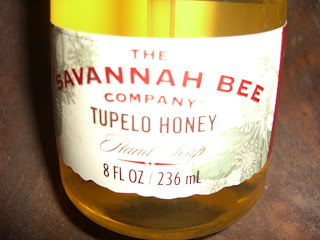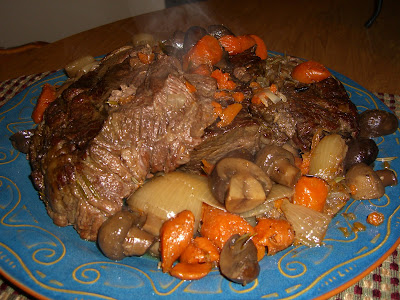 Thanks to 2 members of the food board I frequent, Dana and Stixx for this recipe. Baklava is one recipe I have always wanted to try but was too intimidated by phyllo to give it a go. I finally said "I can do this" and I did. It wasn't as pretty as Dana's. I think I cut too many diagonal lines. Oh well. I had a bite late last night and it sure tasted good. I also didn't put in as many layers of phyllo as I should have between the layers of nuts. I read and re-read the recipe about 10 times and still I screwed it up. It did taste like Baklava should, so I guess I didn't screw it up too badly.
Thanks to 2 members of the food board I frequent, Dana and Stixx for this recipe. Baklava is one recipe I have always wanted to try but was too intimidated by phyllo to give it a go. I finally said "I can do this" and I did. It wasn't as pretty as Dana's. I think I cut too many diagonal lines. Oh well. I had a bite late last night and it sure tasted good. I also didn't put in as many layers of phyllo as I should have between the layers of nuts. I read and re-read the recipe about 10 times and still I screwed it up. It did taste like Baklava should, so I guess I didn't screw it up too badly.
Baklava
Makes one 9x13 glass pan of goodness. Serve with strong coffee or a couple of gallons of milk.A syringe of insulin might also prove to be handy.
Nut mixture
Half pound walnuts
Half pound almonds
1/2 c. sugar
2 t. cinnamon
Syrup
1 1/2 c. sugar
1 1/2 c. water
2 T. honey
1 T. lemon juice
1 cinnamon stick
Several whole cloves (We used 4 and it was good.)
1 package of phyllo (one from a 16 oz. -two package box)
1 c. (two sticks) unsalted butter, melted
Defrost the phyllo according to the directions on the box. Heat oven to 300.
Meanwhile, gather the ingredients.
In a medium saucepan (small one will make a mess as syrup boils), combine all ingredients and bring to a boil. Let boil (higher than simmer, but not raging boil) for 15 minutes. As Alton Brown says, this is pretty much "culinary napalm" so be careful with that syrup. When the 15 minutes is up, turn off the heat, let it cool a bit and then put it in the refrigerator.
While the syrup is boiling, chop the nuts in food processor until slightly coarse. (I find it easier to do the almonds first, then add the walnuts and pulse a couple times more). Add sugar and cinnamon and pulse a few times until combined. Transfer to medium bowl. Don't have a food processor? No problem. You can put them in a gallon-sized freezer bag and pound the heck outts them .Take 13x9 Pyrex pan and place on counter with the bowl of nu ts next to it. Take the phyllo out of package and unroll. They will likely be 13x9-ish. (If you got the huge sheets, slice in half the short way and the resulting halves should be only slightly larger than the pan.) There are also packages that have the phyllo in two wrapped packages. These are already the right size.
ts next to it. Take the phyllo out of package and unroll. They will likely be 13x9-ish. (If you got the huge sheets, slice in half the short way and the resulting halves should be only slightly larger than the pan.) There are also packages that have the phyllo in two wrapped packages. These are already the right size.
Working with Phyllo dough: You really need to keep the dough moist while working with it. Take this part seriously.It's easy, just do it. You will want to wet two still-connected paper towels and wring most of the moisture out and keep them on the phyllo when you're not taking a sheet. Failure to do this will result in disaster in a short time. Greek grandmas and aunts will sometimes use a kitchen towel. Whatever floats your boat.With a pastry brush, coat the bottom and sides of the pan with melted butter (I keep the butter in the saucepan I melted it in on the lowest burner setting at all times). Take one layer of phyllo and lay it on the bottom of the pan. (Me? I buttered my bottom.) If it's slightly too long or wide, just fold the edge over, it's okay. Cover the remaining phyllo and brush the sheet in the pan with more melted butter. Repeat five times so that you have six layers of phyllo and butter on the bottom.
The butter. Don't skimp. Besides providing flavor, you are creating a fat layer between the pieces which gives it the flaky crispy texture - while keeping it from simply being layer upon layer of dry stuff that sticks in the back of your throat. This fat layer is important. I heard someplace you can use oil. I suppose you could do that...I'm sticking with butter.Then take a handful of the nut mixture and sprinkle over the top. Spread it around so that it covers in a thin, even layer. Take another phyllo sheet and lay on top of the nut mixture. This next phyllo layer (the one that goes on the nut mixture) is always the hardest to spread the melted butter onto. You may have to use your fingers to keep it in place. Once it's buttered, repeat the phyllo and butter process two more times so that you have three layers on the nuts. Spread more nuts as before. Continue the nuts and three layers of buttered phyllo process until you have five or six sheets of phyllo left. This will be your top layer. These get the individual butter treatment as well. BEFORE YOU STICK THE PAN IN THE OVEN:You have to cut it into diamond shapes. I find it easier to make nine or ten cuts parallel to the longest side, then diagonal cuts. Um, I didn't follow his directions. So, my pieces have that, er, "rustic" look. Sure, that's the ticket. They're "rustic." I'll be following his directions next time... You will need a sharp knife to do this. Dip the knife in hot water if it sticks and the phyllo starts to pull and tear. Once it's cut into diamonds, pour any remaining melted butter evenly over the top. Then put it in the oven. Bake 55-65 minutes, but I'd check after 45 minutes just to be sure. The top layers should be tinged with light brown and because it's a glass pan, you should see slightly darker orange layers at the bottom. AS SOON AS IT COMES OUT OF THE OVEN:Take the syrup out of the fridge, take out the cinnamon stick and cloves, and spoon the syrup all over the baklava. I tend to follow the cut lines, but just make sure that every piece gets some luscious syrup and don't forget the edges. Did he say "spoon?" Oh, we didn't read that part either. We poured it right outta the pan - well, outta a measuring cup. The cold syrup on the hot phyllo bubbled and gurgled and sputtered. It was pretty fun. *I did the same thing, just poured it on.
I'm sure what I did to this recipe would horrify a Greek Grandma. It may not look like the beautiful Baklava I see at the Greek festival, but it sure tastes like it.
























 I am new to the burger world. I didn't eat red meat for 25 years and I am slowly getting back my love of the hamburger. I have to say the burger I ordered was wonderful. It's hard to get a wonderful outta me over a burger, but this one was. I got the Route 66 burger
I am new to the burger world. I didn't eat red meat for 25 years and I am slowly getting back my love of the hamburger. I have to say the burger I ordered was wonderful. It's hard to get a wonderful outta me over a burger, but this one was. I got the Route 66 burger 
























